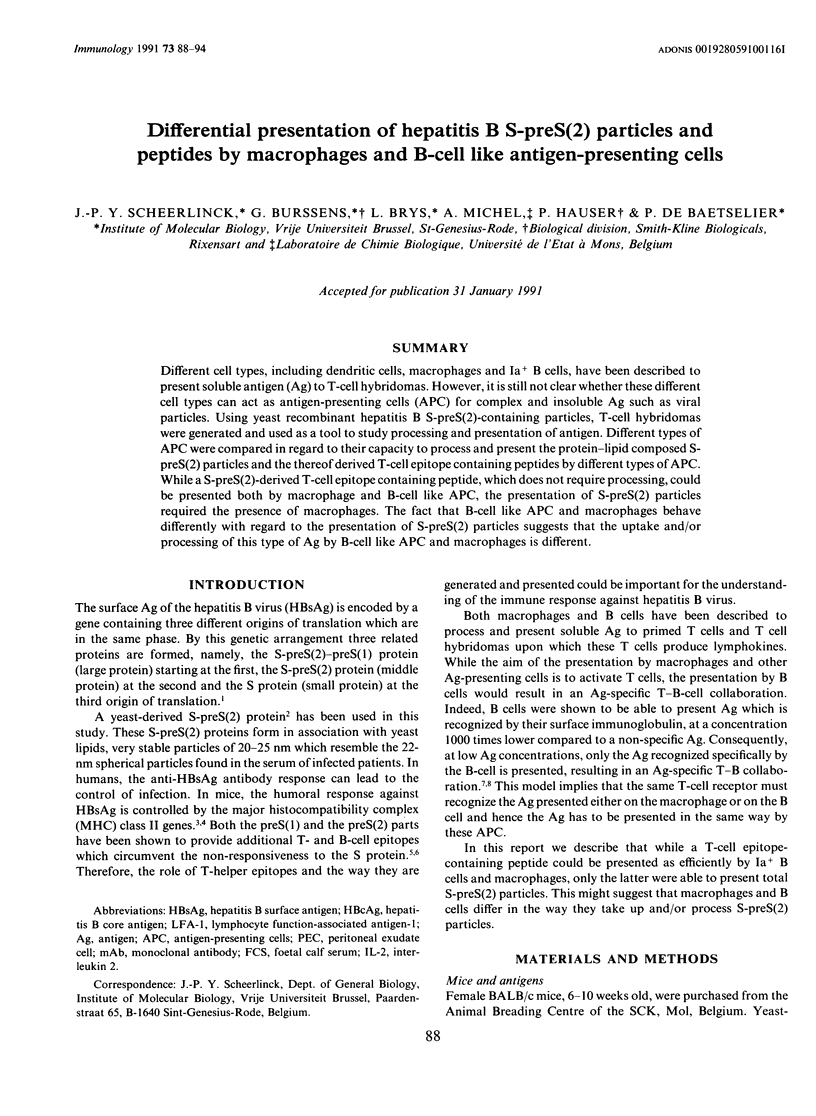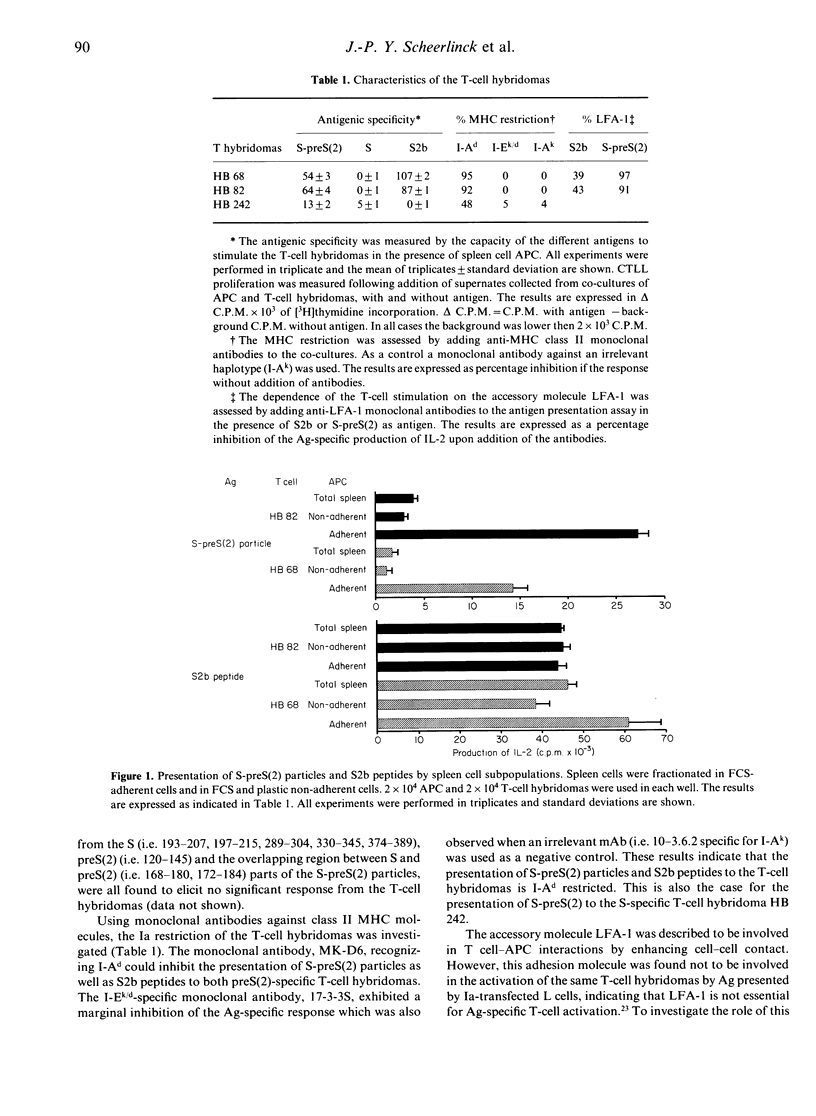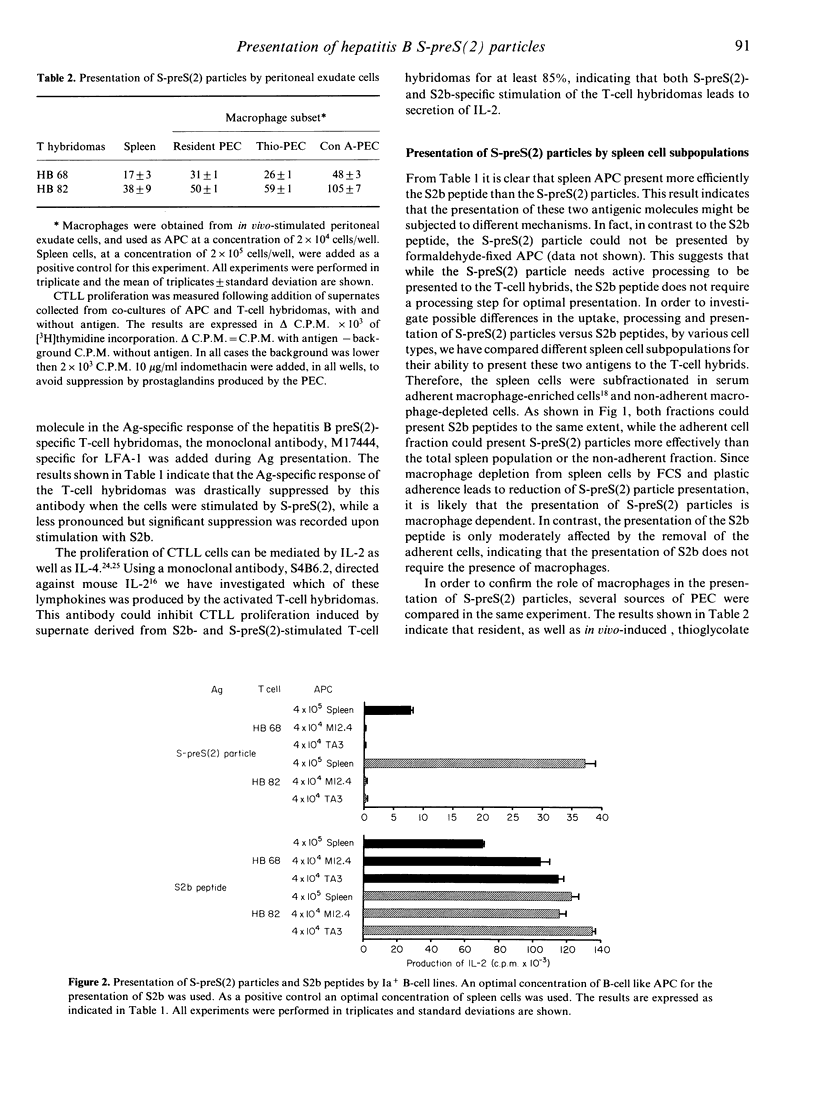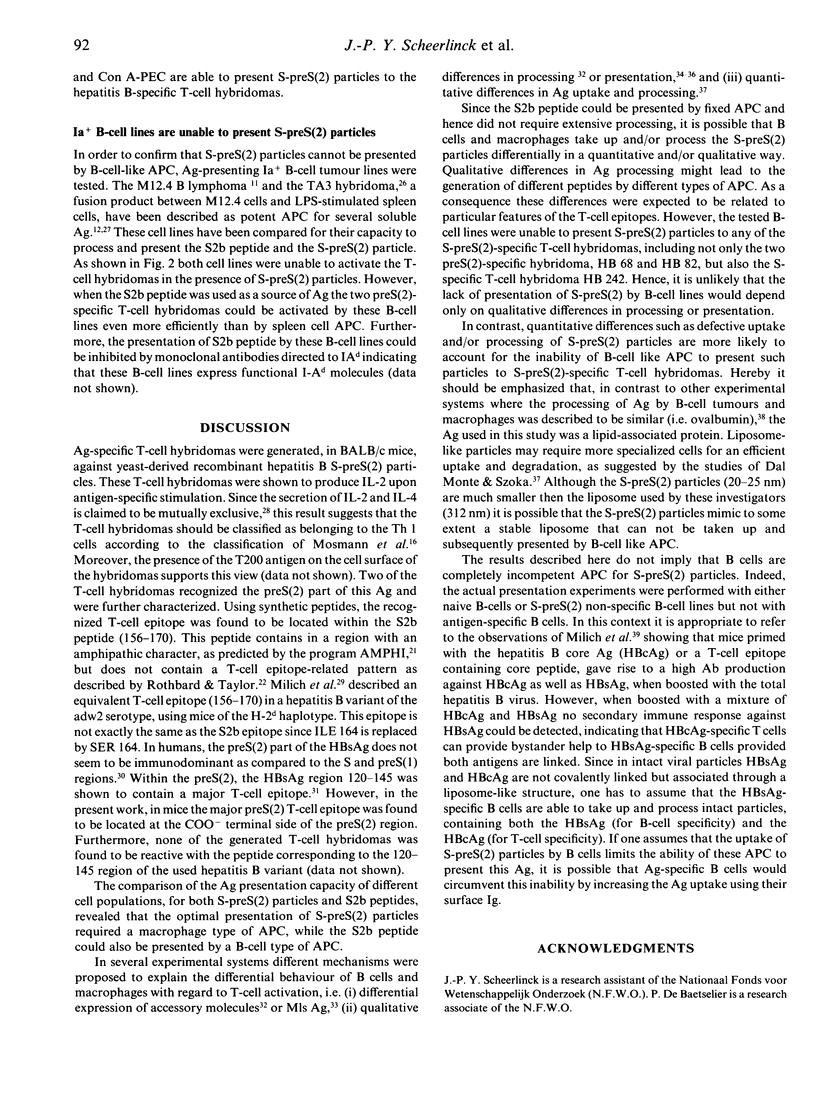Abstract
Different cell types, including dendritic cells, macrophages and Ia+ B cells, have been described to present soluble antigen (Ag) to T-cell hybridomas. However, it is still not clear whether these different cell types can act as antigen-presenting cells (APC) for complex and insoluble Ag such as viral particles. Using yeast recombinant hepatitis B S-preS(2)-containing particles, T-cell hybridomas were generated and used as a tool to study processing and presentation of antigen. Different types of APC were compared in regard to their capacity to process and present the protein-lipid composed S-preS(2) particles and the thereof derived T-cell epitope containing peptides by different types of APC. While a S-preS(2)-derived T-cell epitope containing peptide, which does not require processing, could be presented both by macrophage and B-cell like APC, the presentation of S-preS(2) particles required the presence of macrophages. The fact that B-cell like APC and macrophages behave differently with regard to the presentation of S-preS(2) particles suggest that the uptake and/or processing of this type of Ag by B-cell like APC and macrophages is different.
Full text
PDF






Selected References
These references are in PubMed. This may not be the complete list of references from this article.
- Abbas A. K., Haber S., Rock K. L. Antigen presentation by hapten-specific B lymphocytes. II. Specificity and properties of antigen-presenting B lymphocytes, and function of immunoglobulin receptors. J Immunol. 1985 Sep;135(3):1661–1667. [PubMed] [Google Scholar]
- Baumhüter S., Bron C., Corradin G. Different antigen-presenting cells differ in their capacity to induce lymphokine production and proliferation of an apo-cytochrome c-specific T cell clone. J Immunol. 1985 Aug;135(2):989–994. [PubMed] [Google Scholar]
- Bottomly K., Luqman M., Greenbaum L., Carding S., West J., Pasqualini T., Murphy D. B. A monoclonal antibody to murine CD45R distinguishes CD4 T cell populations that produce different cytokines. Eur J Immunol. 1989 Apr;19(4):617–623. doi: 10.1002/eji.1830190407. [DOI] [PubMed] [Google Scholar]
- Chesnut R. W., Colon S. M., Grey H. M. Requirements for the processing of antigens by antigen-presenting B cells. I. Functional comparison of B cell tumors and macrophages. J Immunol. 1982 Dec;129(6):2382–2388. [PubMed] [Google Scholar]
- Cowing C., Chapdelaine J. M. T cells discriminate between Ia antigens expressed on allogeneic accessory cells and B cells: a potential function for carbohydrate side chains on Ia molecules. Proc Natl Acad Sci U S A. 1983 Oct;80(19):6000–6004. doi: 10.1073/pnas.80.19.6000. [DOI] [PMC free article] [PubMed] [Google Scholar]
- Cullen S. E., Kindle C. S., Shreffler D. C., Cowing C. Differential glycosylation of murine B cell and spleen adherent cell Ia antigens. J Immunol. 1981 Oct;127(4):1478–1484. [PubMed] [Google Scholar]
- Dal Monte P., Szoka F. C., Jr Effect of liposome encapsulation on antigen presentation in vitro. Comparison of presentation by peritoneal macrophages and B cell tumors. J Immunol. 1989 Mar 1;142(5):1437–1443. [PubMed] [Google Scholar]
- Davignon D., Martz E., Reynolds T., Kürzinger K., Springer T. A. Lymphocyte function-associated antigen 1 (LFA-1): a surface antigen distinct from Lyt-2,3 that participates in T lymphocyte-mediated killing. Proc Natl Acad Sci U S A. 1981 Jul;78(7):4535–4539. doi: 10.1073/pnas.78.7.4535. [DOI] [PMC free article] [PubMed] [Google Scholar]
- Dekruyff R. H., Cantor H., Dorf M. E. Activation requirements of cloned inducer T cells. II. The failure of some clones to respond to antigen presented by activated B cells. J Immunol. 1986 Jan;136(2):446–451. [PubMed] [Google Scholar]
- Ferrari C., Penna A., Bertoletti A., Cavalli A., Valli A., Schianchi C., Fiaccadori F. The preS1 antigen of hepatitis B virus is highly immunogenic at the T cell level in man. J Clin Invest. 1989 Oct;84(4):1314–1319. doi: 10.1172/JCI114299. [DOI] [PMC free article] [PubMed] [Google Scholar]
- Gillis S., Ferm M. M., Ou W., Smith K. A. T cell growth factor: parameters of production and a quantitative microassay for activity. J Immunol. 1978 Jun;120(6):2027–2032. [PubMed] [Google Scholar]
- Glimcher L. H., Hamano T., Asofsky R., Sachs D. H., Pierres M., Samelson L. E., Sharrow S. O., Paul W. E. IA mutant functional antigen-presenting cell lines. J Immunol. 1983 May;130(5):2287–2294. [PubMed] [Google Scholar]
- Glimcher L. H., Sharrow S. O., Paul W. E. Serologic and functional characterization of a panel of antigen-presenting cell lines expressing mutant I-A class II molecules. J Exp Med. 1983 Nov 1;158(5):1573–1588. doi: 10.1084/jem.158.5.1573. [DOI] [PMC free article] [PubMed] [Google Scholar]
- Golde W. T., Kappler J. W., Greenstein J., Malissen B., Hood L., Marrack P. Major histocompatibility complex-restricted antigen receptor on T cells. VIII. Role of the LFA-1 molecule. J Exp Med. 1985 Mar 1;161(3):635–640. doi: 10.1084/jem.161.3.635. [DOI] [PMC free article] [PubMed] [Google Scholar]
- Grabstein K., Eisenman J., Mochizuki D., Shanebeck K., Conlon P., Hopp T., March C., Gillis S. Purification to homogeneity of B cell stimulating factor. A molecule that stimulates proliferation of multiple lymphokine-dependent cell lines. J Exp Med. 1986 Jun 1;163(6):1405–1414. doi: 10.1084/jem.163.6.1405. [DOI] [PMC free article] [PubMed] [Google Scholar]
- Hamano T., Kim K. J., Leiserson W. M., Asofsky R. Establishment of B cell hybridomas with B cell surface antigens. J Immunol. 1982 Oct;129(4):1403–1406. [PubMed] [Google Scholar]
- Kappler J. W., Skidmore B., White J., Marrack P. Antigen-inducible, H-2-restricted, interleukin-2-producing T cell hybridomas. Lack of independent antigen and H-2 recognition. J Exp Med. 1981 May 1;153(5):1198–1214. doi: 10.1084/jem.153.5.1198. [DOI] [PMC free article] [PubMed] [Google Scholar]
- Kim K. J., Kanellopoulos-Langevin C., Merwin R. M., Sachs D. H., Asofsky R. Establishment and characterization of BALB/c lymphoma lines with B cell properties. J Immunol. 1979 Feb;122(2):549–554. [PubMed] [Google Scholar]
- Kumagai K., Itoh K., Hinuma S., Tada M. Pretreatment of plastic Petri dishes with fetal calf serum. A simple method for macrophage isolation. J Immunol Methods. 1979;29(1):17–25. doi: 10.1016/0022-1759(79)90121-2. [DOI] [PubMed] [Google Scholar]
- Margalit H., Spouge J. L., Cornette J. L., Cease K. B., Delisi C., Berzofsky J. A. Prediction of immunodominant helper T cell antigenic sites from the primary sequence. J Immunol. 1987 Apr 1;138(7):2213–2229. [PubMed] [Google Scholar]
- Metzger Z., Hoffeld J. T., Oppenheim J. J. Macrophage-mediated suppression. I. Evidence for participation of both hdyrogen peroxide and prostaglandins in suppression of murine lymphocyte proliferation. J Immunol. 1980 Feb;124(2):983–988. [PubMed] [Google Scholar]
- Milich D. R., Alexander H., Chisari F. V. Genetic regulation of the immune response to hepatitis B surface antigen (HBsAg). III. Circumvention of nonresponsiveness in mice bearing HBsAg nonresponder haplotypes. J Immunol. 1983 Mar;130(3):1401–1407. [PubMed] [Google Scholar]
- Milich D. R., Hughes J. L., McLachlan A., Langley K. E., Thornton G. B., Jones J. E. Importance of subtype in the immune response to the pre-S(2) region of the hepatitis B surface antigen. I. T cell fine specificity. J Immunol. 1990 May 1;144(9):3535–3543. [PubMed] [Google Scholar]
- Milich D. R., Louie R. E., Chisari F. V. Genetic regulation of the immune response to hepatitis B surface antigen (HBsAg). V. T cell proliferative response and cellular interactions. J Immunol. 1985 Jun;134(6):4194–4202. [PubMed] [Google Scholar]
- Milich D. R., McLachlan A., Chisari F. V., Kent S. B., Thorton G. B. Immune response to the pre-S(1) region of the hepatitis B surface antigen (HBsAg): a pre-S(1)-specific T cell response can bypass nonresponsiveness to the pre-S(2) and S regions of HBsAg. J Immunol. 1986 Jul 1;137(1):315–322. [PubMed] [Google Scholar]
- Milich D. R., McLachlan A., Thornton G. B., Hughes J. L. Antibody production to the nucleocapsid and envelope of the hepatitis B virus primed by a single synthetic T cell site. Nature. 1987 Oct 8;329(6139):547–549. doi: 10.1038/329547a0. [DOI] [PubMed] [Google Scholar]
- Milich D. R., McNamara M. K., McLachlan A., Thornton G. B., Chisari F. V. Distinct H-2-linked regulation of T-cell responses to the pre-S and S regions of the same hepatitis B surface antigen polypeptide allows circumvention of nonresponsiveness to the S region. Proc Natl Acad Sci U S A. 1985 Dec;82(23):8168–8172. doi: 10.1073/pnas.82.23.8168. [DOI] [PMC free article] [PubMed] [Google Scholar]
- Minami M., Kawasaki H., Taira S., Nariuchi H. Alloantigen presentation by B cells: two types of alloreactive T cell hybridomas, B cell-reactive and B cell-nonreactive. J Immunol. 1985 Jul;135(1):111–116. [PubMed] [Google Scholar]
- Mosmann T. R., Cherwinski H., Bond M. W., Giedlin M. A., Coffman R. L. Two types of murine helper T cell clone. I. Definition according to profiles of lymphokine activities and secreted proteins. J Immunol. 1986 Apr 1;136(7):2348–2357. [PubMed] [Google Scholar]
- Oi V. T., Jones P. P., Goding J. W., Herzenberg L. A., Herzenberg L. A. Properties of monoclonal antibodies to mouse Ig allotypes, H-2, and Ia antigens. Curr Top Microbiol Immunol. 1978;81:115–120. doi: 10.1007/978-3-642-67448-8_18. [DOI] [PubMed] [Google Scholar]
- Ozato K., Mayer N., Sachs D. H. Hybridoma cell lines secreting monoclonal antibodies to mouse H-2 and Ia antigens. J Immunol. 1980 Feb;124(2):533–540. [PubMed] [Google Scholar]
- Rock K. L., Benacerraf B., Abbas A. K. Antigen presentation by hapten-specific B lymphocytes. I. Role of surface immunoglobulin receptors. J Exp Med. 1984 Oct 1;160(4):1102–1113. doi: 10.1084/jem.160.4.1102. [DOI] [PMC free article] [PubMed] [Google Scholar]
- Roos E., La Rivière G., Collard J. G., Stukart M. J., De Baetselier P. Invasiveness of T-cell hybridomas in vitro and their metastatic potential in vivo. Cancer Res. 1985 Dec;45(12 Pt 1):6238–6243. [PubMed] [Google Scholar]
- Rothbard J. B., Taylor W. R. A sequence pattern common to T cell epitopes. EMBO J. 1988 Jan;7(1):93–100. doi: 10.1002/j.1460-2075.1988.tb02787.x. [DOI] [PMC free article] [PubMed] [Google Scholar]
- Tiollais P., Charnay P., Vyas G. N. Biology of hepatitis B virus. Science. 1981 Jul 24;213(4506):406–411. doi: 10.1126/science.6264599. [DOI] [PubMed] [Google Scholar]


